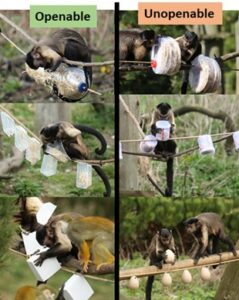
Back in April, Living Links hosted an exciting Primate Pop-Up as part of the Edinburgh International Science Festival. Read on to hear about the importance of play, and how zoo visitors took part in an experiment investigating how monkeys learn through play.
Learning through Play
Play is a big part of human life, especially in childhood. It is also a behaviour found in many other animal species. The fact that play is found across the animal kingdom suggests that it must be a valuable behaviour for survival: if it were not advantageous in some way, it would not have evolved. So, the question is – why do we play, if not just for fun?
Right about now you may be wondering what exactly play is. This is a good question – one that comparative researchers have been struggling to answer for years, as common definitions of play tend to be human-centred. Graham and Burghardt (2010) developed a set of criteria that can be used to identify play in any animal species. Play behaviour (1) has no obvious purpose; (2) is enjoyable, rewarding, or spontaneous; (3) is different from day-to-day behaviours (for example, play fighting is more exaggerated than real fighting); (4) is done repeatedly; and (5) is done when relaxed.
Research at Living Links is exploring the idea that that one of the biggest values of play is that it helps us to learn. Children will play when there is something to find out – when they are curious. In a 2011 experiment, researchers gave children a toy that lit up and played music only when specific beads were placed on it. Children tested each possibility in turn, and if two beads were stuck together, they would turn the beads on their ends to try them out one at a time. This behaviour is very similar to how scientists devise experiments! Just through exploratory play, the children were able to learn and remember how the music box worked.

Learning Through Play at the Primate Pop-Up
Animals also like to play around with objects: look at the Living Links monkeys investigating objects that are openable versus un-openable (Figure 1). They played around with the objects in various ways: hitting them and banging them, spinning them around and even roly-polying with them! When they were later given the chance to come into the research rooms, then knew which objects were easy to open and which were difficult. However, even monkeys that did not have a chance to play were pretty good at choosing the right object, so we’ll need to make the task harder in the future!
At the Primate Pop-Up Event, we wanted to observe learning in action, by giving the Living Links monkeys an exciting new resource: crackers! The crackers either contained a jackpot (high value trail mix) or some basic vegetables. We wanted to see if the monkeys were able to learn which resource had high value. Visitors to the pop-up helped create these crackers by filling up cardboard tubes with either low value or high value treats, and then wrapping them in paper. The jackpot crackers were wrapped in black paper, and the basic crackers in brown paper. The monkeys were then given the crackers, while the visitors helped keep track of their selection.

At the beginning, the monkeys were actually scared of the jackpot crackers! This is because they were not used to the black paper and were suspicious of the novelty. So early on in the afternoon, monkeys only chose the basic crackers. However, they eventually decided to explore the black crackers, leading to an even split of choices between the two cracker types. When the same experiment was carried out on the second day of the event, there was a clear preference for the black crackers. This suggests that the monkeys learned which resource had a higher value, just through playing with them!
The results of the Primate Pop-Up experiment showed just how quickly monkeys engage with their environment and learn about it. We also spent time with the children that visited on the day talking about a future experiment in which we could look at how monkeys learn even when there isn’t any feedback (like food rewards). You can see some of their suggestions in figure 3.
Playing can be a way of conducting informal science experiments, by trying out new behaviours and manipulations and seeing what happens. This helps build up new skills, like tool use and problem-solving. Though traditionally we might think of play as without a real purpose, the research continues to prove this idea wrong – it seems that play is some serious fun!

